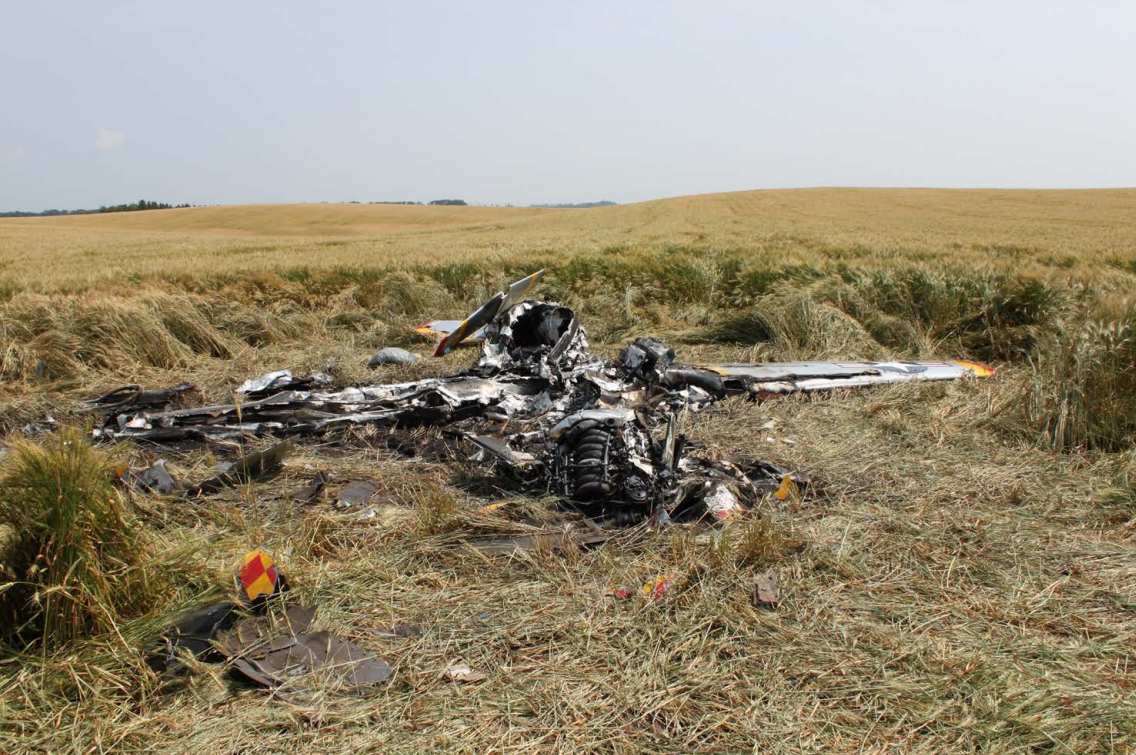
ASN Wikibase Occurrence # 168195
This information is added by users of ASN. Neither ASN nor the Flight Safety Foundation are responsible for the completeness or correctness of this information.
If you feel this information is incomplete or incorrect, you can submit corrected information.
| Date: | Thursday 31 July 2014 |
| Time: | 19:30 |
| Type: | Few P-51 Mustang |
| Owner/operator: | Private |
| Registration: | N116LK |
| MSN: | 12 |
| Year of manufacture: | 2011 |
| Engine model: | Chevrolet LS-1 |
| Fatalities: | Fatalities: 1 / Occupants: 1 |
| Aircraft damage: | Destroyed |
| Category: | Accident |
| Location: | NW of Lisbon, ND -
 United States of America United States of America
|
| Phase: | En route |
| Nature: | Private |
| Departure airport: | Lisbon Municipal Airport, ND (6L3) |
| Lisbon Municipal Airport, ND (6L3) | |
| Investigating agency: | NTSB |
| Confidence Rating: |
The private pilot was conducting a local flight in the experimental amateur-built airplane. Recorded flight data showed that about 2 minutes before the end of the flight, the airplane's airspeed began to decrease, which was followed by a decrease in altitude. Engine parameters were not recorded. Multiple witnesses reported hearing unusual engine sounds coming from the airplane. One witness reported that the airplane's nose rose slightly, and then the airplane rolled and began a slow spin toward the ground. The witness lost sight of the airplane as it went behind a tree line, and a few seconds later, he saw a plume of smoke. Postaccident examination of the airplane revealed no anomalies with regard to the airframe or flight control system. Engine crankshaft and valve train continuity was confirmed. The engine was a converted automobile engine and used electronic ignition and fuel injection components. Testing of the ignition and fuel injection systems was not possible due to the extensive impact and postcrash fire damage.
Based on the recorded flight data and witness observations, the airplane's engine lost partial power, resulting in the pilot's inability to maintain the airplane's altitude. As the airplane descended, the pilot allowed the airplane's airspeed to decrease to the point where the wing's angle-of-attack exceeded its critical angle-of-attack, resulting in an aerodynamic stall followed by a spin. The stall/spin occurred at an altitude that was too low for recovery. The reason for the loss of engine power could not be determined based on the available evidence.
Probable Cause: The partial loss of engine power for a reason that could not be determined because of extensive impact and postcrash fire damage, and the pilot's failure to maintain adequate airspeed, which resulted in the airplane's wing exceeding its critical angle-of-attack and a subsequent aerodynamic stall/spin.
Accident investigation:
 |
|
Sources:
NTSB
FAA register: http://registry.faa.gov/aircraftinquiry/NNum_Results.aspx?NNumbertxt=N116LK
Location
Images:

Photo: NTSB
Revision history:
| Date/time | Contributor | Updates |
|---|---|---|
| 01-Aug-2014 20:12 | Geno | Added |
| 01-Aug-2014 22:51 | Geno | Updated [Registration, Nature, Source, Narrative] |
| 21-Dec-2016 19:28 | ASN Update Bot | Updated [Time, Damage, Category, Investigating agency] |
| 30-Nov-2017 18:53 | ASN Update Bot | Updated [Operator, Other fatalities, Departure airport, Destination airport, Source, Narrative] |
| 10-Apr-2022 16:00 | Captain Adam | Updated [Other fatalities, Location, Phase, Departure airport, Destination airport, Source, Narrative, Photo] |
Corrections or additions? ... Edit this accident description
The Aviation Safety Network is an exclusive service provided by:


 ©2024 Flight Safety Foundation
©2024 Flight Safety Foundation